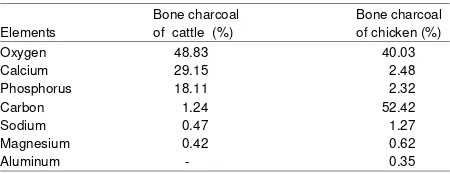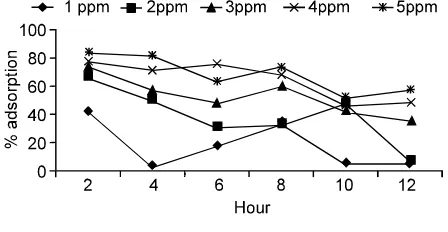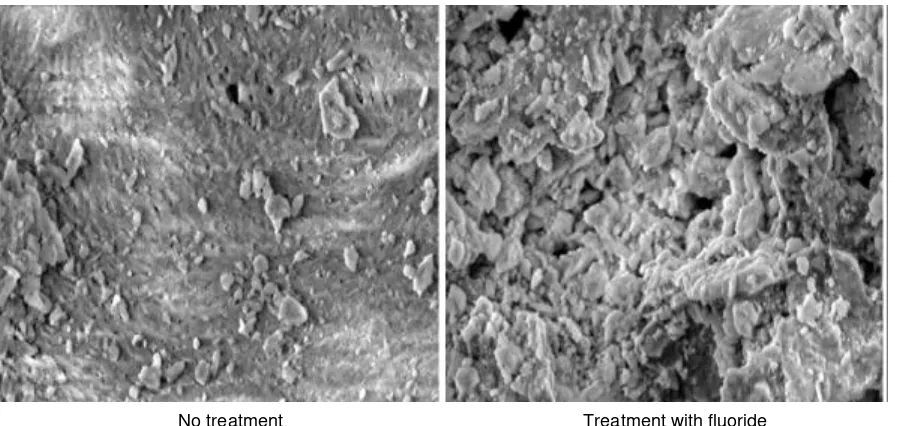ISSN 1682-8356
© Asian Network for Scientific Information, 2014
Corresponding Author: Nova Rugayah, Animal Husbandry, Faculty of Animal Science and Fishery, Tadulako University, Kampus Bumi Tadulako Tondo, Jl. Soekarno Hatta Km 9 Tondo, Palu Sulawesi Tengah 94118, Indonesia
Chicken Bone Charcoal for Defluoridation of Groundwater in Indonesia
Nova Rugayah , Muladno , Henny Nuraini and Salundik1 2 2 2
Department of Animal Husbandry, Faculty of Animal Science and Fishery, Tadulako University, 1
Kampus Bumi Tadulako Tondo, Jl. Soekarno Hatta Km 9 Tondo, Palu Sulawesi Tengah-94118 Department of Animal Production and Technology, Faculty of Animal Science, 2
Bogor Agricultural University, Jl. Agatis Kampus IPB, Darmaga, Bogor, Jawa Barat-16680, Indonesia
Abstract: Animal bone waste in Indonesia is quite high due to the high consumption of chicken, beef and pork. Bone charcoal is charcoal made from animal bones which can be utilized for reducing levels of fluoride (F) in groundwater. This study is aimed to assess the utilization of chicken bones into charcoal to reduce levels of fluoride (defluoridation) groundwater in Indonesia. Materials used in this study are chicken bones as raw materials for bone charcoal. The measured variables were (1) The quality of chicken bone charcoal, (2) Adsorption capacity of the bone charcoal to Fluoride in groundwater. The results showed that chicken bone charcoal consists of O2, Ca, P, C, Na, Mg and Al. Chicken bone charcoal has a quite high of the adsorption capacity as much as 67%. The more chicken bone charcoal is added to the higher percentage of Fluoride tends to increase the adsorption capacity up to 12 h. Therefore, chicken bone waste has a high potency to be processed become chicken bone charcoal for defluoridation of ground water.
Key words: Chicken bone charcoal, defluoridation, fluoride, groundwater
INTRODUCTION
Bone charcoal is a granular material produced by burning animal bones (charring animal bones). The bone charcoal can be applied to the process of water defluoridation and removal of heavy metals from aqueous solutions. Bone Charcoal is mostly composed of calcium phosphate and a small amount of carbon. Bone charcoal typically has a lower surface area than activated carbon, but with a high absorption capacity for copper (Cu), zinc (Zn) and cadmium (Cd) (Wilson et al., 2003; Choy and McKay, 2005).
In Indonesia, especially in rural areas, groundwater is the largest source of water for public consumption. According to the UNICEF report, Thailand and 25 other countries, including Indonesia, have a fairly high concentration of fluoride in groundwater. In 2006 the WHO stated that the maximum limit recommended levels of fluoride in drinking water is 1.5 mg/L (Smittakorn et al., 2010). Utilization of animal bone charcoal to filter drinking water is beneficial to reduce levels of fluoride in groundwater and drinking water which is still very rarely applied in Indonesia. In fact, this
simple technology can be applied in rural areas, MATERIALS AND METHODS
especially those with Fluoride content that exceeds the This research was conducted from January to December WHO recommendation. 2013. Bone charcoal is produced in the Laboratory of Excessive Fluoride levels in consumed drinking water Animal Products Technology Faculty of Animal Science, are a serious threat to public health because it has great Bogor Agricultural University. Test of the Fluoride content potential to cause long-term health hazards. Fluoride in groundwater conducted in Labkesda Jakarta. Test for intake that exceeds the drinking water standards can element content of bone charcoal (Test EDX and SEM) lead to dental, fluorosis, or even crippling skeletal applied at Integrated Laboratory, Center for Engineering (Fawell et al., 2006). Several studies have also found that fluorosis caused by high concentrations of fluoride is also potentially to create a variety of serious health problems. Liver and kidney damage has been documented by Xiong et al. (2007) and has been found in adolescent males a correlation between a high intake of fluoride and bone cancer called Osteosarcoma
(Bassin et al., 2006).
0 t
0 C - C % adsorption x 100
C
of Forestry and Forest Products Processing. Tests for where, C0 are initial concentration and Ct = the bone charcoal defluoridation in groundwater conducted
at Integrated Laboratory, Bogor Agricultural University. Material research: Materials used in this study are animal bones from chicken and cattle (being comparing factor) as materials for bone charcoal, distilled water and Sodium Fluoride (NaF) for synthetic water as well as groundwater containing Fluoride as much as 3 ppm is used as samples for testing adsorption capacity of bone charcoal. The groundwater is taken from the area in Bogor.
Research methods
Making of bone charcoal: Bone charcoal making process consists of four stages, as follows: (1) Process of cleaning the bones of the remains of meat and fat attached, (2) Process of boiling the bones, for 1-5 h depending on the type of bone, (3) Process of drying the bone, using an oven temperature of 60°C for 24 h, 4) Process of burning the bones, using a furnace temperature of 600°C for 1-2.5 h in which the chicken bones for 60-90 min and cattle bones for 120-150 min. The resulting bone charcoal is grayish black, brittle and odorless with a size of about 1-2 mm.
Making "the batch adsorption experiment" with synthetic water: The synthetic water made by mixing NaF with distilled water with F varied at concentrations of 1-5 mg/L. Adding chicken bone char as much as 10 g to 100 mL of water with a concentration of synthetic F, respectively 1, 2, 3, 4 and 5 ppm in polyethylene bottles. The same procedure is also applied on the cattle bone char. The bottles are then placed in a water bath at room temperature and measured the concentration of F after 2, 4, 6, 8, 10 and 12 h using a spectrophotometer (AAS method).
Making "the batch adsorption experiment" with ground water: Preparing the ground water at a F concentration of 3 ppm. Adding chicken bone char as much as 2, 4, 6, 8, 10 and 12 g in 100 mL of ground water into polyethylene bottles. The same procedure is also done on the cattle bone char. The bottles are then placed in a water bath at room temperature and measured the concentration of F after 2, 4, 6, 8, 10 and 12 h using a spectrophotometer (AAS method).
Parameters: The measured parameters are quality of chicken bone charcoal as well as adsorption capacity, to measure the percentage of Fluoride in the original solution sorbed to bone char at any time, t, can be expressed as a percentage of the initial concentration by the following equation:
concentration at time t in mg/L.
Data analysis: All obtained data were descriptively analyzed.
RESULTS AND DISCUSSION
Quality of chicken and cattle bone charcoal: The content of the elements that are still present in the bone charcoal produced using a very high temperature of 600°C is shown in Table 1.
Table 1 showed that the produced bone char has a fairly high O2 content is >40%, where the cattle bone char has reached the highest O2 content of 48.83% and chicken bone char as much as 40.03%. While the cattle bone char contains elements of 29.15% Ca and P as 18.11% which was significantly higher than the content of a chicken bone char is less than 3%. Chicken bone char contain elements of C are very high reached 52.42% compared to cattle bone char is only 1:24%.
Carbon element produced by chicken bone char, although much higher than cattle bone char, it still does not meet the range of better carbon content of 85-95% (Okeola and Odebunmi, 2010). It is important to be concerned when the heating takes place, efforts should be made to prevent air leaks in the heating room so that the carbon-containing material is only carbonized and do not oxidized.
According to Sudradjat et al. (2005), charcoal is not only used as fuel, but also can be used as an adsorbent. Adsorption is determined by the surface area of particles and this ability can be higher if the charcoal is activated with the active factor of chemicals or by heating at high temperature. Thus, the charcoal will change in physical and chemical properties. Charcoal is thus referred to as activated charcoal. Cattle and chicken bone charcoal has a high enough adsorption to Fluoride because it is processed by heating at high temperature (600°C), although without activation. Cattle and chicken bone charcoal is enough potential for further processed into activated charcoal because the higher carbon content, the better it is used as raw material for the manufacture of activated charcoal.
The bone charcoal is mainly composed of calcium hydroxyapatite (CAHA), carbon and calcium carbonate. Hydroxyapatite has a good ability to remove inorganic Table 1: Element contents of cattle and chicken bone charcoal
cations that can be developed to eliminate the use of heavy metals in contaminated water (Pan et al., 2009). Physical crystal of hydroxyapatite is a bioceramics material with a surface structure that has pores (Kubo, 2003).
Extracellular matrices of hard bone tissue are composed of the phases of inorganic and organic. Inorganic phase is primarily composed of crystals of hydroxyapatite (HA) and the organic phase is mainly composed of collagen and small amounts of other compounds including glycosaminoglycans (GAGs),
proteoglycans and glycoprotein (Yildirim, 2004). In Fig. 1: Adsorption capacity of chicken bone charcoal in addition, chemical composition of the constituent bone synthetic water
is on a weight basis, consisting of approximately 69% inorganic, 22% organic and 9% water. While the base volume that is 40% inorganic, 35% organic and 25% water. The main organic phase of bone is collagen (90% weight). The main inorganic phase of bones is a crystalline mineral salt, as calcium phosphate, which is often idealized as hydroxylapatite also called hydroxyapatite. While the inorganic phase of bone is hydroxyapatite (CA10(PO4)6(OH)2) and additionally also contained salts of sodium, magnesium, potassium, chlorine, fluorine, CaCO3, Ca3(PO4)2 and citrate in varying
amounts (Yuwanta, 2004). Fig. 2: Adsorption capacity of cattle bone charcoal in Adsorption capacity of bone charcoal: The adsorption
percentage (% adsorption) chicken and cattle bone charcoal to fluoride in synthetic water can be seen in Fig. 1 and 2.
Figure 1 and 2 show the difference in the percentage of adsorption (% adsorption) between chicken and cattle bone charcoal to F in the synthetic water containing F 1 ppm up to 5 ppm. Percentage of adsorption cattle bone charcoal tends to be higher than chicken bone charcoal to all tested F concentrations. Percentage of adsorption cattle and chicken bone charcoal to F in the synthetic water is directly proportional to the F concentration in the synthetic water where higher F concentrations in the synthetic water result in the higher percentage of adsorption cattle and chicken bone charcoal to the F elements.
This is differently demonstrated by the increase in the percentage of adsorption cattle and chicken bone charcoal to the F element. The percent adsorption of cattle and chicken bone charcoal on the F element is inversely proportional to the increase in the percentage of adsorption itself where the higher F concentration in the synthetic water the lower increase in the adsorption percentage of cattle and chicken bone charcoal to F element. The percentage of adsorption cattle and chicken bone charcoal to the F element at a 1 ppm concentration as much as 30%, increasing to 48% at a concentration of 2 ppm with the increase in the percentage of adsorption as much as 18%, then increased to 59% at a concentration of 3 ppm with the
synthetic water
increase in adsorption percentage is only 11%. Furthermore, the adsorption percentage increase only 7% at a concentration of 4 ppm, although the adsorption percentage reached to 66%. Finally, the increase of adsorption percentage decreased to only 4% at a concentration of 5 ppm with the highest percentage of adsorption as much as 70%.
Figure 3 and 4 show the difference in the percentage of adsorption (% adsorption) between the cattle and chicken bone charcoal to the F content in groundwater with in the number of bone charcoal varies from 2, 4, 6, 8, 10 to 12 g with a length of adsorption for 2, 4, 6, 8, 10 to 12 h. The adsorption percentage of cattle bone charcoal to F in groundwater tend to be higher than the chicken bone charcoal at various levels and the length of adsorption. Cattle bone charcoal has the highest adsorption capacity to the F by 77%, followed by a chicken bone charcoal as much as 67%.
Fig. 3: Adsorption percentage of chicken bone charcoal to f in groundwater. Chicken bone charcoal = 67%
Fig. 4: Adsorption percentage of cattle bone charcoal to f in groundwater. Cattle bone charcoal = 77%
No treatment Treatment with fluoride Fig. 5: SEM photo of bone charcoal (1000x)
porous, the force of adhesion results in a material can is absorbed into the pores of calcium hydroxyapatite absorb other substances into the pores. Hydroxyapatite
as one of ceramic material is possible to have the ability for adsorbing other substances into the pores on its surface. Based on this structure the calcium hydroxyapatite has the ability to adsorb other substances to its surface, but also can release ions hydroxyapatite hidroksinya in a relatively acidic environment (Yildirim, 2004).
Percentage of adsorption (% adsorption) chicken and cattle bone charcoal on the F concentration in groundwater is directly proportional to the amount of bones charcoal as well as length of adsorption, where the more bone charcoal added the higher % adsorption of Fluoride and tends to increase the % adsorption from adsorption length of 2 to 12 h.
There are two mechanisms of decreased Fluoride content in groundwater that occur. Firstly, is through a chemical reaction between the compounds contained in cattle and chicken bone charcoal with the fluoride in groundwater. Secondly, is through the adsorption process to the F in cattle and chicken bone charcoal. Fluoride is expected to be adsorbed into the pores of the calcium hydroxyapatite material in cattle and chicken bone charcoal. Hence, in the adsorption process up to 12 h the Fluoride also adsorbed in the pores of calcium hydroxyapatite material.
It was conducted SEM photo to prove the difference of the cattle bone charcoal powder before and after treatment. SEM photo results are shown in Fig. 5. From Fig. 5 shows that the pores of the bone charcoal powder with Fluoride treatments are very much covered by a white material compared with bone charcoal pores without treatment. The white material is believed to Fluor
material. Thus it can be assumed that the adsorption process is quite maximal and is able to make a significant contribution.
Conclusions: Chicken and cattle bone charcoal has potential as defluoridator of groundwater. The elements of cattle bone charcoal are O2, Ca, P, C, Na and Mg, meanwhile chicken bone charcoal additionally contained Al. Cattle bone charcoal has the highest adsorption capacity of Fluoride in groundwater reached 77%, followed by chicken bone charcoal as much as 67%. In groundwater with the Fluoride concentration of 3 ppm, the more bone charcoal is added result in the higher adsorption capacity of Fluoride and tends to increase up to 12 h.
ACKNOWLEDGEMENTS
The authors would like to thank the Higher Education which has provided BPPS scholarships from 2009 to 2014, Doctoral Grant in 2013 and the opportunity to follow the Sandwich Program in 2011 at the University of Sydney, Australia.
REFERENCES
Bassin, E.B., D. Wypij, R.B. Davis and M.A. Mittleman, 2006. Age-specific Fluoride Exposure in Drinking Water and Osteosarcoma. Cancer Cause, Cont., 17: 421-428.
Choy, K.H. and G. McKay, 2005. Sorption of metal ions from aqueous solution using bone char. Environ. Int., 845-854.
Kubo, M., 2003. Hydroxyapatite Ceramics As a Sudradjat, R., D. Tresnawati and D. Setiawan, 2005. Particulate Embolic Material: Report of the Physical Pembuatan Arang Aktif dari Tempurung Biji Jarak Properties of the Hydroxyapatite Particles and the Pagar (Jatropha curcas L). Pusat Litbang Teknologi Animal Study. AJNR Am. J. Neuroradiol., 24: 1540- Hasil Hutan.
1544. Wilson, J.A., I.D. Pulford and S. Thomas, 2003. Sorption
Okeola, F.O. and E.O. Odebunmi, 2010. Freundlich and of Cu and Zn by bone charcoal. Environ. Geochem. Langmuir Isotherms Parameters for Adsorption of and Health, 51-56.
Methylene Blue by Activated Carbon Derived from Xiong X, Liu J, He W, Xia T, He P, Chen X, Yang K, Wang Agrowastes. Adv. in Nat. and Appl. Sci., 4: 281-288. A. 2007. Dose-effect Relationship between drinking Pan, X., J. Wang and D. Zhang, 2009. Sorption of cobalt water fluoride levels and damage to liver and kidney to bone char: Kinetics, competitive sorption and functions in children. Environ. Res., 103: 112-116. mechanism. Desalination, 249: 609-614. Yildirim, O., 2004. Preparation and Characterization of Smittakorn, S., N. Jirawongboonrod, S. Mongkolnchai- Chitosan/Calcium Phosphate Based Composite arunya and D. Durnford, 2010. Homemade Bone Biomaterials. Izmir Institute of Technology Turkey. Charcoal Adsorbent for Defluoridation of Yuwanta, T., 2004. Dasar Ternak Unggas. Kanisius. Groundwater in Thailand. The J. Water and Health, Jakarta (ID). Hal., 62-64.



